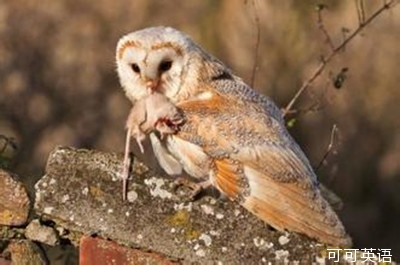Owls are nearly noiseless hunters, swooping down on prey without any warning whoosh.
身为无声的猎人,猫头鹰是总能俯冲向猎物而不发出任何声响。
How do they do it?
这是怎么做到的呢?
We’ve known that the leading edge of an owl's wing has a comb of stiff feathers.
我们已经了解到猫头鹰的翅膀前端有一缕冠状的坚硬羽毛。
 And the trailing edge has a flexible fringe, unlike the rigid trailing edge of a conventional bird wing.
And the trailing edge has a flexible fringe, unlike the rigid trailing edge of a conventional bird wing.
而接下去的尾端则是一小段柔韧的弯曲,不像是一般的羽翼末端那样坚硬。
These two features contribute to a structure that produces almost no noise as it rushes through the air.
这两个特点成就了猫头鹰从天而降几乎无声无息的特点。
Now it appears that these predators have a third trick up their sleeves—or rather, wings—that allow them to be so silent but deadly.
而现在看上去似乎这种捕食者还有第三种独门工具使得它们的行动隐秘而且致命,那就是翅膀。
Researchers modeled the effect of the layer of down on the wing’s top surface.
研究人员们对于猫头鹰在俯冲时羽翼顶端表面上的一层结构的反应进行了模拟。
And it looks like that fluffy stuff absorbs sound too.
这些看上去毛茸茸的物质也能够吸收声音。
The work was presented at a meeting of the American Physical Society's Division of Fluid Dynamics.
这项研究已在《美国物理协会流体动力学分会会刊》杂志上发表。
Mimicking owl wing down may lead to new sound-proofing materials.
模拟猫头鹰俯冲也许能有助于开发新型消音材料。
Down and the other silencing features could inspire wind turbines and plane engines that produce less noise and fewer vibrations.
鸟类绒毛和其它消音结构可以启发风力涡轮机和飞机引擎装置的改进,以起到降噪减震的作用。
So that all we hear is silence.
如果成功我们听到的将只有静谧之声。
 And the trailing edge has a flexible fringe, unlike the rigid trailing edge of a conventional bird wing.
And the trailing edge has a flexible fringe, unlike the rigid trailing edge of a conventional bird wing. And the trailing edge has a flexible fringe, unlike the rigid trailing edge of a conventional bird wing.
And the trailing edge has a flexible fringe, unlike the rigid trailing edge of a conventional bird wing.